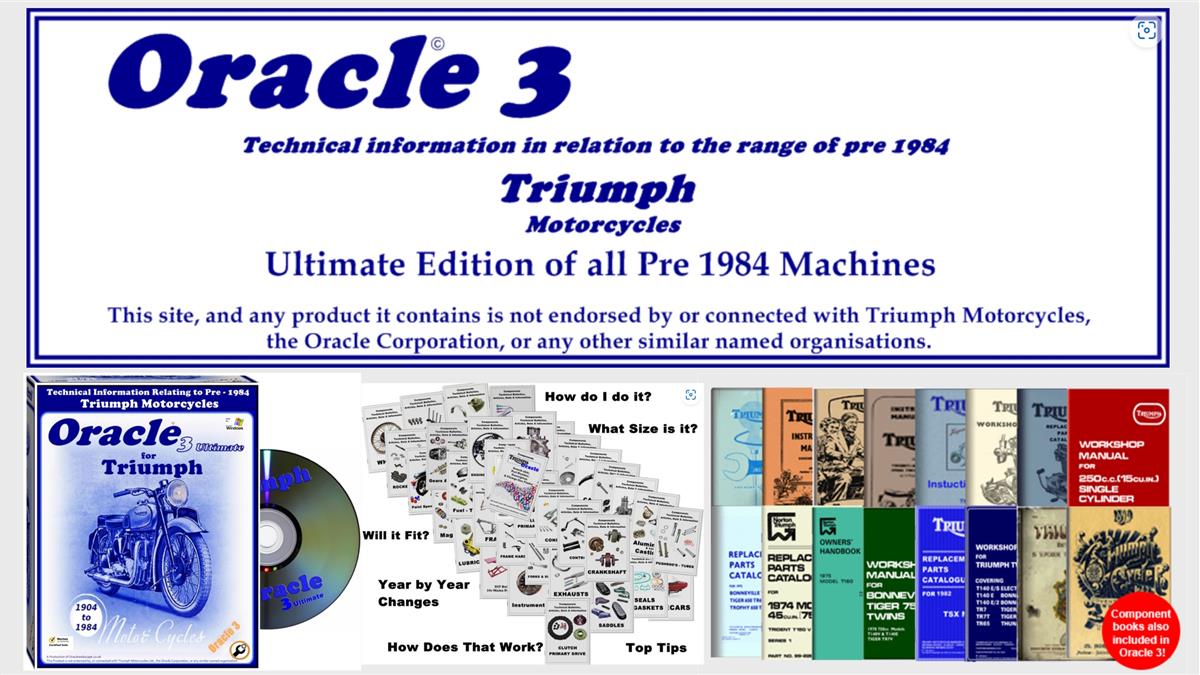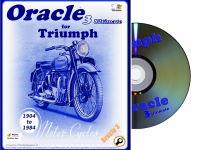
It's about 12 years now since the inception of the Triumph Oracle, that seems a long time ago, barely a day has passed when some detail or article has not been added to this now immense volume of data. So how did it come about? That's an easy question compared to the task of compiling it.
I have spent a lifetime fiddling with and riding Triumph's, spending my youth riding them to work every day and using them to enable holidays both home and abroad. Days past, an average owner was required to know every detail to enable roadside repairs and maintain a machine to give reliable consistent service. Being a member of a breakdown organisation gave little peace of mind. These memories were still fresh when riding my Triumph was interrupted by the inevitable family and riding became an occasional luxury.
Despite going through many makes and incarnations of bikes, I'd thankfully retained the most sentimental machine I'd owned, a 1961 Triumph T110, one previous owner, my brother. Painstakingly I'd rebuilt it from boxes following his transformations into various styles, little was left of the original machine's style, but a Triumphs character is timeless. Rebuilt and on the road to coincide with my 17th birthday, to then be ridden every day for thirteen years. It was coming to the last of these years that the DS crankshaft sheared off on holiday in France, welded up, running just a battery, the bike was eventually consigned to boxes once again.
I re-joined the biking community as many did, with grown up children and a little more money in my pocket, but now with limited endurance following life's mishaps. Fact was, I was forced to recognise limitations in spadefuls, and had to accept I was going to be doing more tinkering than riding, so be it. Motorcycles came and went, and I found myself a niche in doing repairs with the occasional build. I thought I knew quite a lot about Triumphs at the time, though as I was later to discover, I knew zilch.
Come the mid 1980's with teenagers to 'train', The T110 seemed the ideal candidate. I delved into the old boxes, wondering how on earth this machine ran at all, with 80,000 on the clock and the evident 'get you home' repairs, I began to doubt it's viability. The original splendour of design was all but lost, to recreate was it not an option, besides, I'd always preferred the USA TR6 style. If there were one thing I'd learnt from life, function is above form, and with an engineering background, this priority was eminently achievable, and I made the decision. I decided not to labour religiously to follow original specification, just to get the machine to run reliably maintaining the originality of components available. Improvements could follow.
The rebuilding came easy, as I read the workshop manual and parts lists, which I've always valued for their simplicity. Familiar notions of Part numbers and assembly techniques began to take place. Having once worked as a Triumph parts manager, I probably had an advantage and must admit my satisfaction swelled when starting her up on the second kick. My son's attempts at rebuilding the carburettor soon put paid to my smugness as the jet block mysteriously fell out. I compiled a build list, of all the items requiring further attention, improvement, and in some cases, redesign. No rush, here was a project to turn back the years and be savoured, with time and money to lavish, and a series of standby machines for the long hauls.
Triumph spares suppliers were thin on the ground, many that had existed, now gone, familiar ones many miles away. Thankfully, it was the dawning of the internet, unfamiliar dealers' names became apparent, chasing the business of a forgotten era, now burgeoning with late middle aged wannabe's searching out their lost youth, not to mention the machines they grew up with. Classic Triumphs were booming, imports bringing machines back from the four corners of the globe for repatriation. OK, spares quality had become questionable, but at least the choice was there. I became aware of something troubling though, and as a 60's capitalist renegade it began to grate on me. Fellow riders were always grumbling about quality, prices and service, reminding themselves of parts managers who would once have the spare on the counter and receipt written out as they walked through the door. Clearly, things had changed.
It seemed that just about every man and his dog were jumping on the bandwagon selling anything at a premium with the name of Triumph attached to it, much of it questionable quality, much of it misrepresented, (may also fit). I looked on the holy grail of side show Bob's sites and began to become disillusioned just what was being marketed in the Triumph name. Perhaps it was vanity, perhaps it was social conscience, perhaps it was shear, bloody mindedness of realising rosy eyed people like myself were being misled to part with money at exorbitant rates for questionable products where returns never became an option.
Time use and mill dew had taken its toll on my coveted Triumph manuals, non-more so than texts of my workshop manual. Genuine new were not available, second hand, extortionate cost. It soon became apparent that these were being alternatively marketed in the then new pdf electronic format, but disappointingly as terrible reproduction scans, many incomplete, incorrect and scarred and no improvement on what I had. Perhaps the worst examples were 're-Copyrighted' or emblazoned with commercial advertising, by both individuals and major players. Inevitably I began to read of Triumph, that quite rightly, were up in arms of those trying to re assign ownership of their property. Sharing is one thing, kidnap & ransom another.
During a conversation with a TOMCC member in the pub, yes, it's always in the pub, I began to formulate an idea that if one could compile as close to the sum of human knowledge on classic Triumphs within a single volume not only would it be a monumental achievement in help for owners, it could, 'by the way', be a method to undermine this flagrant money making scam. An impossible task, but I reasoned that were I to make the technical literature accessible at a low cost, why would anyone wish to be exploited by a few soulless profiteers. After spending some time researching the publication market it was clear I was alone, sellers had no interest in anything other than using Triumph data to further their own agenda. I knew business and knew these players should know better. So began the assembly of Triumph classical literature as a useful compilation allowing the true context of Triumphs evolution to be technically examined.
This facet of evolution was something even Triumph in their day had not addressed. There were thousands of technical bulletins, changes to parts list, appendixes and supplements, to every model that give clues, but rarely addressed as a true reflection of the whole. Much of this information was consigned to factory employees' personal knowledge, who while themselves, eminent, only possessed a fragment of the overall picture. With the demise of Meriden, these former employees shared their knowledge and experience by writing their own publications, but rationally, limited to a single model and/or period, expansion beyond may have understandably proved just a step to far. Trying to piece this jigsaw puzzle together in a single accessible format was going to be a challenge.
Oh, but what about the internet, that burgeoning pool of expertise at the touch of a button. Forums were expanding and drawing in new talent and experts and experts by the droves to answer elusive questions. Well, here's the problem, as a research tool it's unparalleled, but for every respected and talented contributor, there are a thousand, usually well meaning, but misleading readers in line muddying the waters. Most readers do not know who has a correct answer, and those that do, are few and far between. Some even think they have a right to demand expertise at the touch of a button, between these, accuracy and accessibility suffers as a result. Besides, how many repetitive strings of discussion would have to be read before arriving at an informed conclusion, and if you do, as is often the case, no one size fits all. Confused, so is everybody else.
Triumph Oracle 1 was first published 2009, involving a not insignificant monetary investment, not to mention time, in a simple assembly of all the years publications I could muster. Many of which required extensive remedial work to be at all legible, never mind accurate. Assembled as a single volume arranged by decade with a few extras thrown in, this was well received and a viable option to others available. It soon became clear that having adjacent years books for cross reference was a valuable tool to the reader, the volume of material spanning 80 years however, transpired to exceed even my estimations, You may recall what I said about function over form, well Oracle is the same, it's not memorabilia, it's observable rational data, This data, it's analysis, interpretation and expansion would shape the future Oracle 2 and 3. I took the decision to research all the major component parts so a reader could evaluate interchangeability for a following edition.
Oracle 2. Intended to be the culmination of knowledge from both official and received wisdom of empirical data, but Oracle 2 turned out to be only half the story. The raw data was vast, it was mixed up, it was incoherent, only a very long road would give the story, and then potentially context inaccurate. Few, if any, individuals held the knowledge on all the facets that influence these machines, and they are becoming increasingly thin on the ground. Oracle 2 turned out to be a turning point at which I recognised the data needed further research, collation and processing. Even computer search engines failed to contextualise the points needed by users to make a quick informed decision on what and how to use a component or technique to best advantage. A journey of a thousand miles starts with a single step kept coming to mind, this was a swamp that could swallow me.
With the introduction of a separate 'Components' to the volume, each of these individual items could be focused upon in detail, in their history, evolution and refinement. The 'Components' sections, some 33, would become the core of the Oracle, the workshop manuals and parts manuals simply a working reference. It should be said, that while all the Oracle manuals are still included, some recomposed in their entirety, editorially enhanced and with corrections, originals are now in re-print and available in pristine original condition by official licenced publishers, essential in a workshop without a PC screen. Care should be taken however as there are still a few counterfeits out there.
Oracle 3. Over 40,000 pages in nearly 400 books of indexed data, information and categorised component sections with illustrations, analysis, comparison, explanation, investigation, yearly change notes and factory bulletins. Occupying over 3.3 Megabytes of electronic information, phew, it's a mouthful just to say. The received wisdom of official Triumph & Triumph suppliers' publications and researched empirical data that pins down those questions that seem to rumble on forever. Having identified the most sought-after answers for the novice, Oracle three also delves into the reasons for evolution and change for the discerning enthusiast, with some surprising results and unexpected reading. I would be the first to concede, that no one publication can hold it all, small but important detail can always come to light, Oracle 3 however, if not the world's largest and most and most comprehensive volume of Classical Triumph data will give more than many others combined.
I have been adding features to Oracle 3 for some time now, focusing down on known irregularities and investigating solutions daily. As a result, each Oracle 3 copy, has to date the potential to have more material than the last copy. I now find that fresh data holds little new and the process I set out to achieve is drawing successfully to a close. Should you purchase Oracle 3, you will find it at the same cost it was first released, and if you discover anything new, you can add your own notes to many of the pages, and perhaps continue your own journey, as I will, into retirement.
By Chris Hickie, Oracle 3 Editor.










